美国药典级甘油
- 格式:doc
- 大小:41.50 KB
- 文档页数:1
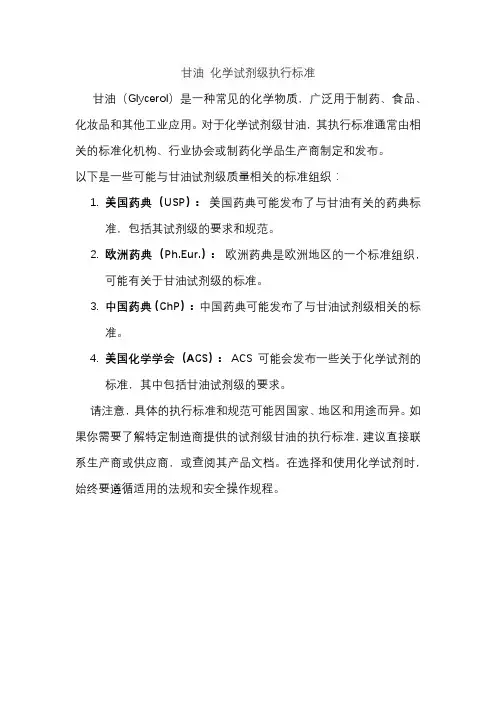
甘油化学试剂级执行标准
甘油(Glycerol)是一种常见的化学物质,广泛用于制药、食品、化妆品和其他工业应用。
对于化学试剂级甘油,其执行标准通常由相关的标准化机构、行业协会或制药化学品生产商制定和发布。
以下是一些可能与甘油试剂级质量相关的标准组织:
1.美国药典(USP):美国药典可能发布了与甘油有关的药典标
准,包括其试剂级的要求和规范。
2.欧洲药典(Ph.Eur.):欧洲药典是欧洲地区的一个标准组织,
可能有关于甘油试剂级的标准。
3.中国药典(ChP):中国药典可能发布了与甘油试剂级相关的标
准。
4.美国化学学会(ACS):ACS 可能会发布一些关于化学试剂的
标准,其中包括甘油试剂级的要求。
请注意,具体的执行标准和规范可能因国家、地区和用途而异。
如果你需要了解特定制造商提供的试剂级甘油的执行标准,建议直接联系生产商或供应商,或查阅其产品文档。
在选择和使用化学试剂时,始终要遵循适用的法规和安全操作规程。

甘油有什么功效甘油是一种渗透性脱水药,具有吸湿性和润滑性,口服或胃肠外给药时,甘油能增加血浆渗透压,造成水分从细胞外间隙通过渗透作用转移至血浆。
甘油有什么功效1甘油又名丙三醇,是一种无色、无臭、味甘的粘稠液体.甘油是食品加工业中常用的.甜味剂和保湿剂,多用于运动食品和代乳品中.冬季人们常用甘油搽于暴露在空气中的皮肤表面,如手和脸,可使皮肤保持柔软、有弹性,防止灰尘、气候等对皮肤造成的伤害,同时还能防止皮肤冻伤.由于甘油能增加人体组织中的水分,因此可增加人体在高温环境下的运动能力。
甘油指丙三醇,国家标准称为甘油,无色、无臭、味甜,外观呈澄明黏稠液态,是一种有机物。
1779年由斯柴尔(Scheel)首先发现。
丙三醇能从空气中吸收潮气,也能吸收硫化氢、氰化氢和二氧化硫。
难溶于苯、氯仿、四氯化碳、二硫化碳、石油醚和油类。
与水和醇类、胺类、酚类以任何比例混溶,水溶液为中性。
溶于11倍的乙酸乙酯,约500倍的乙醚。
不溶于苯、氯仿、四氯化碳、二硫化碳、石油醚、油类、长链脂肪醇。
可燃,遇二氧化铬、氯酸钾等强氧化剂能引起燃烧和爆炸。
扩展资料:化学性质:与酸发生酯化反应,如与苯二甲酸酯化生成醇酸树脂。
与酯发生酯交换反应。
与氯化氢反应生成氯代醇。
甘油脱水有两种方式:分子间脱水得到二甘油和聚甘油;分子内脱水得到丙烯醛。
甘油与碱反应生成醇化物,与醛、酮反应生成缩醛与缩酮。
用稀硝酸氧化生成甘油醛和二羟基丙酮;用高碘酸氧化生成甲酸和甲醛。
与强氧化剂如铬酸酐、氯酸钾或高锰酸钾接触,能引起燃烧或爆炸。
甘油也能起硝化和乙酰化等作用。
甘油有什么功效2甘油的作用与功效与作用每逢秋冬季,大多数地区的空气都非常干燥,因此人们的皮肤也容易变得干燥,皮肤干燥时会出现刺痛,此外还会出现脱皮、瘙痒等症状,此时最重要的是给皮肤补水,比如可以使用一些含有甘油的护肤品,因为甘油有良好的保湿效果,另外甘油还有以下几种作用。
甘油对皮肤的作用及功效:众所周知,甘油是最常用的保湿剂,它不仅能牢牢地锁住皮肤的水分,起到保湿的作用,而且对人体的皮肤组织和毛发组织具有显著的润泽作用,可增强护肤品的溶解和渗透能力。
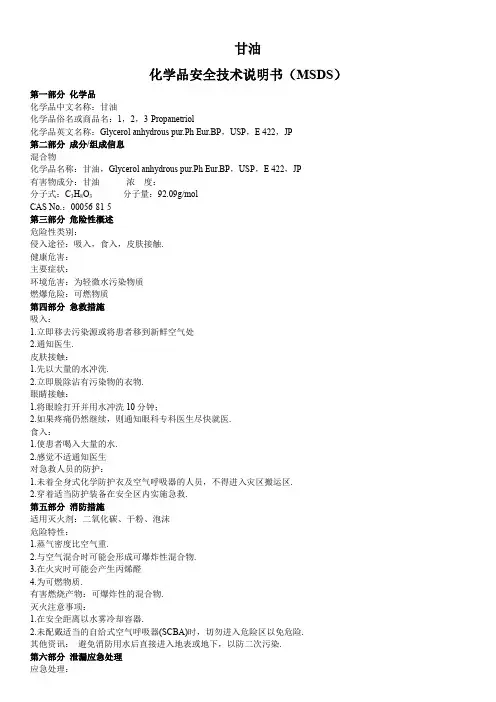
甘油化学品安全技术说明书(MSDS)第一部分化学品化学品中文名称:甘油化学品俗名或商品名:1,2,3-Propanetriol化学品英文名称:Glycerol anhydrous pur.Ph Eur.BP,USP,E 422,JP第二部分成分/组成信息混合物化学品名称:甘油,Glycerol anhydrous pur.Ph Eur.BP,USP,E 422,JP有害物成分:甘油浓度:-分子式:C3H8O3分子量:92.09g/molCAS No.:00056-81-5第三部分危险性概述危险性类别:-侵入途径:吸入,食入,皮肤接触.健康危害:-主要症状:-环境危害:为轻微水污染物质燃爆危险:可燃物质第四部分急救措施吸入:1.立即移去污染源或将患者移到新鲜空气处2.通知医生.皮肤接触:1.先以大量的水冲洗.2.立即脱除沾有污染物的衣物.眼睛接触:1.将眼睑打开并用水冲洗10分钟;2.如果疼痛仍然继续,则通知眼科专科医生尽快就医.食入:1.使患者喝入大量的水.2.感觉不适通知医生对急救人员的防护:1.未着全身式化学防护衣及空气呼吸器的人员,不得进入灾区搬运区.2.穿着适当防护装备在安全区内实施急救.第五部分消防措施适用灭火剂:二氧化碳、干粉、泡沫危险特性:1.蒸气密度比空气重.2.与空气混合时可能会形成可爆炸性混合物.3.在火灾时可能会产生丙烯醛4.为可燃物质.有害燃烧产物:可爆炸性的混合物.灭火注意事项:1.在安全距离以水雾冷却容器.2.未配戴适当的自给式空气呼吸器(SCBA)时,切勿进入危险区以免危险.其他资讯:避免消防用水后直接进入地表或地下,以防二次污染.第六部分泄漏应急处理应急处理:1.不可吸入此物质的蒸气或气溶胶.2.在污染区尚未完全清理干净前,限制人员进入该污染区.3.确定清理工作由受过训的人员负责.4.在污染区的清理人员应穿戴适当的个人防护设备.5.询问供应商,清除该外泄污染源的适当吸收剂或除污液.环境注意事项:1.对该区进行通风换气.2.扑灭或移开该区所有引燃物.3.避免外泄物进入下水道,水沟或密闭空间内.4.若物质释放到周围环境,则应通知当地环保相关单位.消除方法:1.不要碰触外泄物.2.避免外泄物进入下水道,水沟或密闭空间内.3.如安全状况许可,将溢漏的容器移至户外或隔离的通风场所中.4.将其中物质换装到其它适当的容器中,并加以标示.5.清理废弃物,清洗污染区.其他注意事项:已污染的吸收剂,与外泄物具有同等之危害性.第七部分操作处置与储存操作注意事项:无特别要求.储存注意事项:1.储存于密闭容器内,置于阴凉干燥的地方,并远离一般作业场所及不相容物.2.储存区应有独立的通风系统,且无热源,明火及火花.3.储存温度:无限制.第八部分接触控制/个体防护最高容许浓度:八小时日时量平均允许浓度:-短时间时量平均容许浓度:-最高容许浓度:-生物指标:-MAK(德国作业环境最高容许浓度):-监测方法:-工程控制:-呼吸系统防护:需要,当蒸气/气溶胶产生时眼睛防护:需配戴.手防护:不需要,建议使用身体防护:应依环境中有害物之浓度与量来选择此作业场所适用之防护衣.其他防护:-卫生措施:1.工作后尽快脱掉污染的衣物.2.处理此物后,须彻底洗手.第九部分理化特性外观与性状:近乎无味的无色液体pH值:约5 在100g/L H20 @20℃熔点(℃):18℃相对密度(水=1):1.26g/cm3(20℃)闪火点(℃):约180℃相对蒸气密度(空气=1):<0.001hpa(20℃)沸点(℃):290℃(1013hpa)爆炸上限%(V/V):0.9% vol%自燃温度(℃):400℃爆炸下限%(V/V):-溶解性:可溶于水(@20℃);微溶于酒精;不溶于氯仿主要用途:-其他理化性质:-第十部分稳定性和反应活性稳定性:稳定禁配物:强氧化剂,硝酸/浓硫酸,磷氧化物,过氧化物,过氧化氢,卤素.避免接触的条件:强热聚合危害:不会发生分解产物:火灾时会产生丙烯醛其他:在蒸气/气体状态下与空气混合可能会产生爆炸.第十一部分毒理学资料急性毒性:此物质大部分的毒性数据无可用的资料.LD50:12600mg/kg(喂食,大鼠)LD50:>18700mg/kg(皮肤,兔子)皮肤刺激测试(兔子):微刺激性眼睛刺激测试(兔子):微刺激性亚急性至慢毒性:导致敏感性:阴性反应(天竺鼠)长期毒性:为自燃发生物质.吸入:对呼吸系统及肺有轻微刺激性皮肤接触:对皮肤粘膜有轻微刺激性食入:当大量食入时会产生呕吐,胃痛,头痛,嗜睡,想睡,腹泻其他:此物质的其它危害特性不可不予考虑.第十二部分生态学资料生态毒性:此物质大部分的生态毒性数据无可用的资料生物影响:对水中生物具有低危害性.细菌毒性:EC5:>10000mg/l/16h(Ps.putida)EC5:2900mg/l/8d(M.aeruginosa)鱼类毒性:LC50:>5000mg/l/24h(C.auratus,由纯物质计算而得)藻类毒性:EC50:>10000mg/l/24h(Daphnia magra;由纯物质计算而得)水菌毒性:EC50:>10000mg/l/24h(magra 水菌)原生质毒性:EC5:3200mg/l/72h(E.sulcatum)生物降解性:>60%/28d(闭罐测试)迅速的生物降解reduction:COD>70%;BOD>60%;BOD5toCOD>50%生物富集或生物积累性:流布:log P(oct):-2.66(由纯物质计算而得)生物累积性:无生物累积性(logP(o/w)<1)非生物降解性:-其他有害作用:当此物质的操作是在正常合理的状态下进行时,不会有生态影响的问题产生.其他生态资料:BOD71%ofThOD/5d;COD95%ofThOD;ThOD:1.217g/g第十三部分废弃处置废弃物性质:þ 危险废物工业固体废物废弃处置方法:产品:1.EC的法令对此物质或此物质的残留物并不统一规定,化学残留物一般可视为特殊废弃物.2.有关产品的废弃物是依据EC成员国所定相关法令准则及规范来执行.3.我们建议您不是找可告知您如何处理此废弃物公司联系,不然就是付费委托经认可的合格废弃物处理公司来代行处理.包装:1.废弃处置应依法令的规定2.污染物的包装应与原化合物的包装要求相同3.若无法规上的特别要求说明,则未含污染物的包装可采取与家庭废弃物相同的处理方式或是回收.废弃注意事项:-第十四部分运输信息危险货物编号:-UN编号:-包装标志:-包装类别:-包装方法:-运输注意事项:-第十五部分法规信息法规信息:1.国内化学品安全管理法规信息危险化学品安全管理条例(中华人民共和国国务院令第344号)化学危险物品安全管理条例实施细则(化劳发[1992]677号)工作场所安全使用化学品规定([1996]劳部发423号)2.国际法规-第十六部分其他信息参考文献:填表部门:数据审核单位:修改说明:其他信息:。
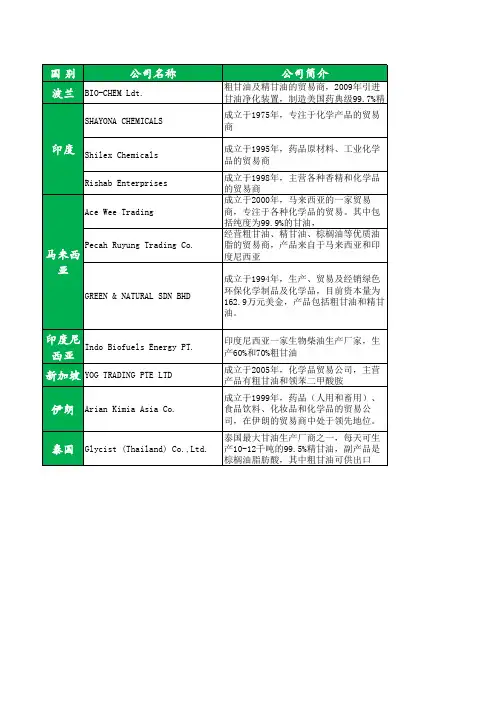
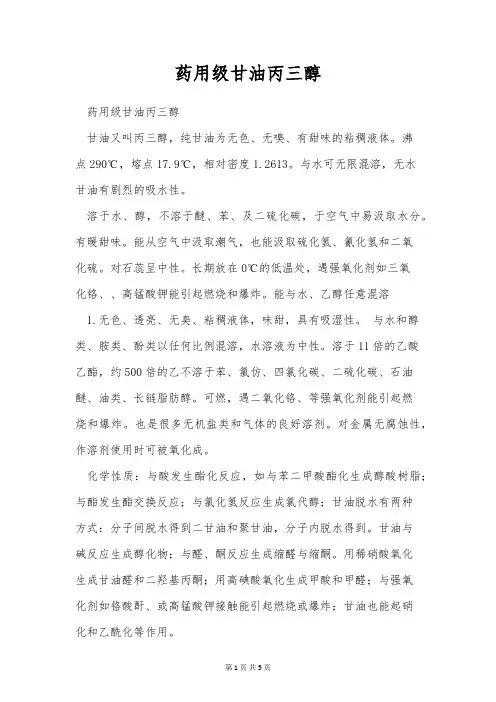
药用级甘油丙三醇药用级甘油丙三醇甘油又叫丙三醇,纯甘油为无色、无嗅、有甜味的粘稠液体。
沸点290℃,熔点17.9℃,相对密度1.2613。
与水可无限混溶,无水甘油有剧烈的吸水性。
溶于水、醇,不溶于醚、苯、及二硫化碳,于空气中易汲取水分。
有暖甜味。
能从空气中汲取潮气,也能汲取硫化氢、氰化氢和二氧化硫。
对石蕊呈中性。
长期放在0℃的低温处,遇强氧化剂如三氧化铬、、高锰酸钾能引起燃烧和爆炸。
能与水、乙醇任意混溶1.无色、透亮、无臭、粘稠液体,味甜,具有吸湿性。
与水和醇类、胺类、酚类以任何比例混溶,水溶液为中性。
溶于11倍的乙酸乙酯,约500倍的乙不溶于苯、氯仿、四氯化碳、二硫化碳、石油醚、油类、长链脂肪醇。
可燃,遇二氧化铬、等强氧化剂能引起燃烧和爆炸。
也是很多无机盐类和气体的良好溶剂。
对金属无腐蚀性,作溶剂使用时可被氧化成。
化学性质:与酸发生酯化反应,如与苯二甲酸酯化生成醇酸树脂;与酯发生酯交换反应;与氯化氢反应生成氯代醇;甘油脱水有两种方式:分子间脱水得到二甘油和聚甘油,分子内脱水得到。
甘油与碱反应生成醇化物;与醛、酮反应生成缩醛与缩酮。
用稀硝酸氧化生成甘油醛和二羟基丙酮;用高碘酸氧化生成甲酸和甲醛;与强氧化剂如铬酸酐、或高锰酸钾接触能引起燃烧或爆炸;甘油也能起硝化和乙酰化等作用。
【鉴别】本品的红外光汲取图谱应与对比图谱(光谱集1268图)全都。
【检查】酸碱度取本品25.0g,加水稀释成50ml,混匀,加酚酞指示液0.5ml,溶液应无色,加0.1mol/L氢氧化钠溶液0.2ml,溶液应显粉红色。
颜色取本品50ml,置50ml纳氏比色管中,与对比液(取比色用重铬酸钾溶液0.2ml,加水稀释至50ml制成)比较,不得更深。
氯化物取本品5.0g,依法检查(通则0801),与标准氯化钠溶液5.0ml制成的对比液比较,不得更浓(0.001%)。
硫酸盐取本品10.0g,依法检查(通则0802),与标准硫酸钾溶液2.0ml制成的对比液比较,不得更浓(0.002%)。

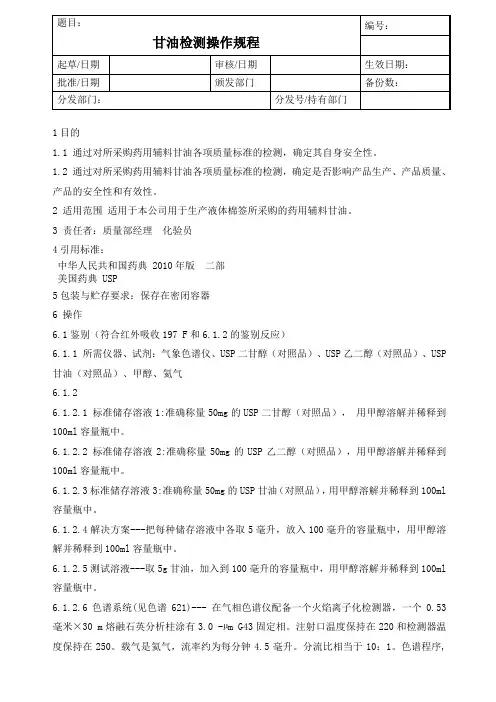
1目的1.1 通过对所采购药用辅料甘油各项质量标准的检测,确定其自身安全性。
1.2 通过对所采购药用辅料甘油各项质量标准的检测,确定是否影响产品生产、产品质量、产品的安全性和有效性。
2 适用范围适用于本公司用于生产液体棉签所采购的药用辅料甘油。
3 责任者:质量部经理化验员4引用标准:中华人民共和国药典 2010年版二部美国药典 USP5包装与贮存要求:保存在密闭容器6 操作6.1鉴别(符合红外吸收197 F和6.1.2的鉴别反应)6.1.1 所需仪器、试剂:气象色谱仪、USP二甘醇(对照品)、USP乙二醇(对照品)、USP 甘油(对照品)、甲醇、氦气6.1.26.1.2.1 标准储存溶液1:准确称量50mg的USP二甘醇(对照品),用甲醇溶解并稀释到100ml容量瓶中。
6.1.2.2 标准储存溶液2:准确称量50mg的USP乙二醇(对照品),用甲醇溶解并稀释到100ml容量瓶中。
6.1.2.3标准储存溶液3:准确称量50mg的USP甘油(对照品),用甲醇溶解并稀释到100ml 容量瓶中。
6.1.2.4解决方案---把每种储存溶液中各取5毫升,放入100毫升的容量瓶中,用甲醇溶解并稀释到100ml容量瓶中。
6.1.2.5测试溶液---取5g甘油,加入到100毫升的容量瓶中,用甲醇溶解并稀释到100ml 容量瓶中。
6.1.2.6色谱系统(见色谱621)--- 在气相色谱仪配备一个火焰离子化检测器,一个0.53毫米×30 m熔融石英分析柱涂有3.0 -µm G43固定相。
注射口温度保持在220和检测器温度保持在250。
载气是氦气,流率约为每分钟4.5毫升。
分流比相当于10:1。
色谱程序,如下所示:最初,柱温是在100,保持4分钟,然后温度以50的比率增加到120,保持10分钟。
然后温度再以50的比率增加到220,保持6分钟。
色谱仪拆分溶液,并记录峰值响应和保留时间。
他相对保留时间约为乙二醇0.3 ,二甘醇0.8,甘油1.0;复制注射的二甘醇的相对标准偏差为不会超过10%。
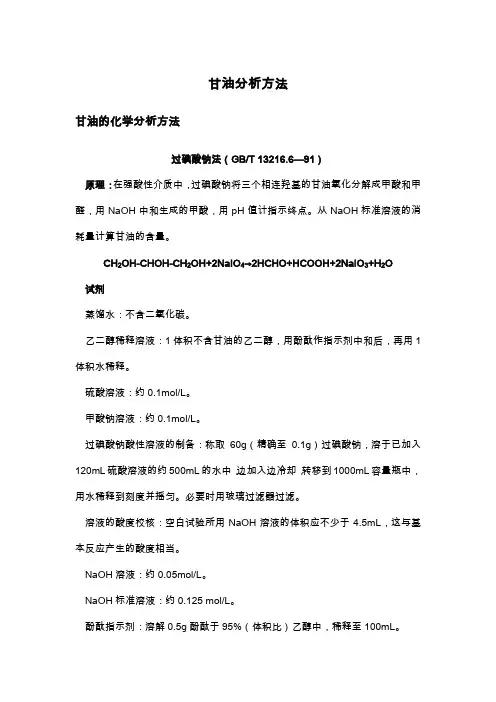
甘油分析方法甘油的化学分析方法过碘酸钠法(GB/T 13216.6—91)原理:在强酸性介质中,过碘酸钠将三个相连羟基的甘油氧化分解成甲酸和甲醛,用NaOH中和生成的甲酸,用pH值计指示终点。
从NaOH标准溶液的消耗量计算甘油的含量。
CH2OH-CHOH-CH2OH+2NaIO4→2HCHO+HCOOH+2NaIO3+H2O试剂蒸馏水:不含二氧化碳。
乙二醇稀释溶液:1体积不含甘油的乙二醇,用酚酞作指示剂中和后,再用1体积水稀释。
硫酸溶液:约0.1mol/L。
甲酸钠溶液:约0.1mol/L。
过碘酸钠酸性溶液的制备:称取60g(精确至0.1g)过碘酸钠,溶于已加入120mL硫酸溶液的约500mL的水中,边加入边冷却,转移到1000mL容量瓶中,用水稀释到刻度并摇匀。
必要时用玻璃过滤器过滤。
溶液的酸度校核:空白试验所用NaOH溶液的体积应不少于4.5mL,这与基本反应产生的酸度相当。
NaOH溶液:约0.05mol/L。
NaOH标准溶液:约0.125 mol/L。
酚酞指示剂:溶解0.5g酚酞于95%(体积比)乙醇中,稀释至100mL。
仪器滴定管:50mL。
pH值计:pH值计应用两种缓冲溶液校准。
a:邻苯二甲酸氢钾溶液:0.05mol/L(10.12g/L),20℃时pH值为4.00;b:10水四硼酸二钠(Na2B4O7·10H2O)溶液:0.01mol/L(3.81g/L),20℃时pH值为9.22。
测定步骤(1)试验份:称取含甘油不大于0.5g的样品(精确至0.0002g)。
如果不知甘油的大致含量,应称取0.5g样品进行预测(如果甘油含量大于75%,最好称取0.5g+0.1g样品,精确至0.0002g),置于500mL容量瓶中,用水稀释至刻度,摇匀后取50mL此溶液用于测定。
(2)试验溶液的制备:对碱性样品或样品酸化时出现焦油沉淀,可将试验份放入配有回流冷凝器的烧瓶中,需要时稀释到50mL,加2滴酚酞指示剂,用硫酸溶液中和到刚好褪色。
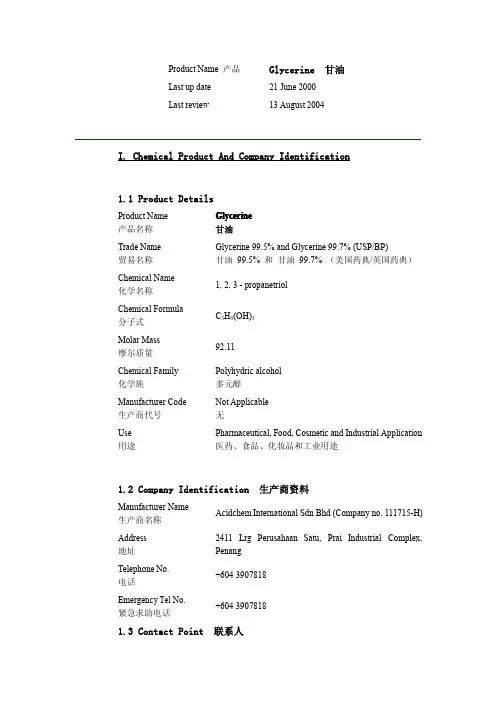
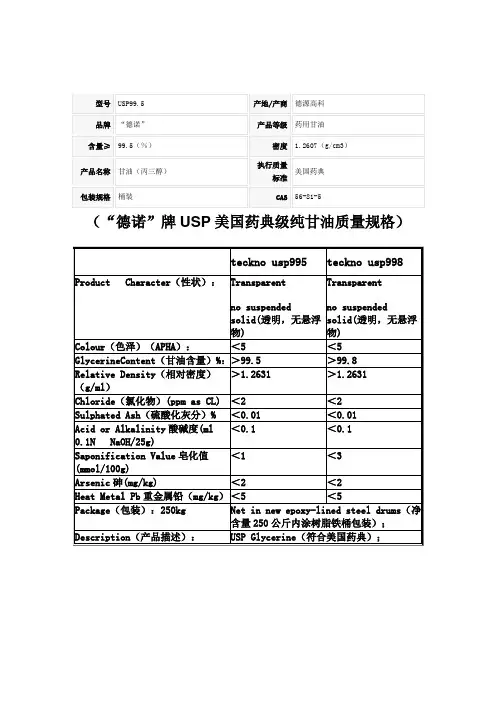

甘油(供注射用)Ganyou(Gongzhusheyong)Glycerol(For Injection)C3H8O392.09颜色照紫外-糖取本品5.0g,加水5ml,混匀,加稀硫酸1ml,置水浴上加热5 分钟,加不含碳酸盐的2m o l / L氢氧化钠溶液[脂肪酸与脂类取本品40g,加新沸的冷水40ml,再精密加氢氧化钠滴定液(0.1mol/L)10ml,摇匀后,煮沸5 分钟,放冷,加酚酞指示液数滴,用盐酸滴定液(0.1mol/L)滴定至红色消失,并将滴定的结果用空白试验校正。
消耗的氢氧化钠滴定液(0.1mol/L)不得过2.0ml。
易炭化物取本品8.0g,在振摇下逐滴加入硫酸5ml,过程中控制温度不得超过20℃,静置1 小时后,如显色,与同体积对照溶液(取比色用氯化钴溶液0.2ml,比色用重铬酸钾溶液1.6ml 与水8.2ml 制成)比较,不得更深。
氯代化物取本品5.0g,加水10ml 和2mol/L 氢氧化钠1ml,混匀,加镍铝合金50mg,置水浴上加热10 分钟,冷却至室温后,滤过,用水20ml 分次洗涤容器和滤渣,将滤液和洗液收集至50ml 纳氏比色管中,加硝酸0.5ml,混匀,再加入硝酸银试液0.5ml,加水至刻度,摇匀。
与标准氯化钠溶液15ml 制成的对照液比较,不得更深(0.003%)。
有关物质取本品约10g,精密称定,置25ml 量瓶中,精密加入内标溶液(每1ml 中含0.5mg 正己醇的甲醇溶液)5m l,用甲醇溶解并稀释至刻度,作为供试品溶液。
取二甘醇、乙二醇、1,2-丙二醇适量,精密称定,用甲醇溶解并稀释制成每1ml 中含二甘醇、乙二醇、铁盐取本品20.0g,依法检查(通则0807),与标准铁溶液1.0ml 制成的对照液比较,不得更深(0.000 05%)。
钙盐取本品2.5g,加水8ml,摇匀,加入草酸铵试液5~6 滴,放置15 分钟,溶液应澄清。
重金属取本品5.0g,依法检查(通则0821 第一法),含重金属不得过百万分之二。
甘油分析方法甘油的化学分析方法过碘酸钠法( GB/T 13216.6—91) 原理:在强酸性介质中,过碘酸钠将三个相连羟基的甘油氧化分解成甲酸和甲醛,用NaOH中和生成的甲酸,用pH值计指示终点。
从NaOH标准溶液的消耗量计算甘油的含量。
CH20H-CHOH-CHOH+2NalC4—2HCHO+HCOOH+2NaI3+H2O试剂蒸馏水:不含二氧化碳。
乙二醇稀释溶液: 1 体积不含甘油的乙二醇,用酚酞作指示剂中和后,再用 1 体积水稀释。
硫酸溶液:约0.1mol/L 。
甲酸钠溶液:约0.1mol/L 。
过碘酸钠酸性溶液的制备:称取60(精确至0.1g)过碘酸钠,溶于已加入120mL 硫酸溶液的约500mL的水中,边加入边冷却,转移到1000mL容量瓶中,用水稀释到刻度并摇匀。
必要时用玻璃过滤器过滤。
溶液的酸度校核:空白试验所用NaOH溶液的体积应不少于4.5mL,这与基本反应产生的酸度相当。
NaOH溶液:约0.05mol/L。
NaOH标准溶液:约0.125 mol/L。
酚酞指示剂:溶解0.5g酚酞于95% (体积比)乙醇中,稀释至100mL o仪器滴定管:50mL。
pH 值计:pH 值计应用两种缓冲溶液校准。
a:邻苯二甲酸氢钾溶液:0.05mol/L (10.12g/L),20C 时pH 值为4.00;b:10 水四硼酸二钠(Na z B4O7T0H2O)溶液:0.01mol/L (3.81g/L), 20C时pH 值为9.22。
测定步骤(1)试验份:称取含甘油不大于0.5g的样品(精确至0.0002g)。
如果不知甘油的大致含量,应称取0.5g样品进行预测(如果甘油含量大于75%,最好称取0.5g+0.1g样品,精确至0.0002g),置于500mL容量瓶中,用水稀释至刻度,摇匀后取50mL此溶液用于测定。
( 2) 试验溶液的制备:对碱性样品或样品酸化时出现焦油沉淀,可将试验份放入配有回流冷凝器的烧瓶中,需要时稀释到50mL,加2滴酚酞指示剂,用硫酸溶液中和到刚好褪色。
它山之石------ USP29“微生物限度检查法”供大家学习参考,我认为USP29内确实有许多值得我们学习的东西,但在编辑《中国药典》时也要考虑到我国实际情况,本着真正能提高药品质量的目的,如一味地照抄照搬别人的东西,就会出现看看药品标准确实是上去了,体面、拿的出去,但在实际应用时不适宜操作,反而降低了对药品质量的控制。
我认为2005年版、2010年版的《中国药典》微生物限度检查法就是如此,2005版药典执行后就开始需要进行药品的验证工作,相同的药品不同的厂家之间要验证;既是同一厂家由于生产原料厂家的改变也要验证,因此各厂家之间出现了五花八门的都称已经验证的检验方法,有的说该方法可行,有的又说该方法不行,天知道这些验证方法的可信度?同时又出台了执行药典通知:以后未经验证的检品不能下“微生物限度检查符合规定”的结论。
我国有这么多的药品生产厂家,作为我国药品的监督检验单位,对药品检验来说怎样去验证,每做一个检品都去验证,这样的工作量现实吗?到今天药典还没有一个对具体样品经验证后较科学的检验方法或指导性方法。
我认为现行的“微生物限度检查”法参照USP的方法对具体的样品验证,并按经验证后的方法进行检验,这确实有利于微生物的检出率,提升药品检验标准。
但应分步进行:可先放在“药典附录指导性原则”内,然后再要求药品生产企业对自己生产的品种进行验证并报地市级以上药品检验所对该方法再次进行检验审核后,再报药典会汇总、审核,在《中国药典》具体品种项下写入检验方法后再开始实施。
目前这一步到位的做法,已从2005年版药典实施开始到2010年版的《中国药典》实施,效果到底怎样?我想:从有关专业杂志的相关文章内也可知一、二。
<61> 微生物限度检查本章所提供的检测程序用于测定包括原料药及制剂在内的各种药品中需氧菌数量以及不含有指定的微生物。
如果已有充分的证据证明某种自动化的方法可以给出与本章所提供的方法等效的或更好的实验结果,可以用该方法替代本章所提供的方法。
Glycerin(glis' er in).C 3H 8O 392.09 1,2,3-Propanetriol;Glycerol [56-81-5].DEFINITIONGlycerin contains NLT 99.0% and NMT 101.0% of C 3H 8O 3, calculated on the anhydrous basis.IDENTIFICATION[NOTE—Compliance is determined by meeting the requirements for Identification tests A, B, and C . ]• A. I NFRARED A BSORPTION 197F• B. L IMIT OF D IETHYLENE G LYCOL AND E THYLENE G LYCOLStandard solution: 2.0 mg/mL of USP Glycerin RS, 0.050 mg/mL of USP Ethylene Glycol RS, 0.050 mg/mL of USP Diethylene Glycol RS, and 0.10 mg/mL of 2,2,2-trichloroethanol (internal standard) in methanolSample solution: 50 mg/mL of Glycerin and 0.10 mg/mL of 2,2,2-trichloroethanol (internal standard) in methanolChromatographic system(See Chromatography 621, System Suitability .)Mode: GCDetector: Flame ionizationColumn: 0.53-mm × 30-m fused-silica analytical column coated with 3.0-µm G43 stationary phase, and a deactivated split liner with glass woolTemperatureInjector: 220Detector: 250Column:See the temperature program table.Initial Temperature ()Temperature Ramp (/min)Final Temperature ()Hold Time at Final Temperature (min)100—10041005012010120502206Carrier gas: HeliumInjection size: 1.0 µLFlow rate: 4.5 mL/minInjection type: Split ratio, about 10:1System suitabilitySample: Standard solution[NOTE—The relative retention times for ethylene glycol, 2,2,2-trichloroethanol,diethylene glycol, and glycerin are about 0.3, 0.6, 0.8 and 1.0, respectively. ]Suitability requirementsResolution: NLT 1.5 between diethylene glycol and glycerinAnalysisSample: Sample solutionAcceptance criteria: If a peak at the retention times for the diethylene glycol orethylene glycol is present in the Sample solution, the peak response ratio relative to 2,2,2-trichloroethanol is NMT the peak response ratio for diethylene glycol orethylene glycol relative to 2,2,2-trichloroethanol in the Standard solution; NMT 0.10% each for diethylene glycol and ethylene glycol is found.• C. Examine the chromatograms obtained in Identification test B. The retention time of the glycerin peak of the Sample solution corresponds to that obtained in theStandard solution.ASSAY• P ROCEDURESodium periodate solution: Dissolve 60 g of sodium metaperiodate in sufficientwater containing 120 mL of 0.1 N sulfuric acid to make 1000 mL. Do not heat todissolve the periodate. If the solution is not clear, pass through a sintered-glass filter.Store the solution in a glass-stoppered, light-resistant container. Test the suitability of this solution as follows. Pipet 10 mL into a 250-mL volumetric flask, and dilute with water to volume. To 550 mg of Glycerin dissolved in 50 mL of water, add 50 mL of the diluted periodate solution with a pipet. For a blank, pipet 50 mL of the solution into a flask containing 50 mL of water. Allow the solutions to stand for 30 min, then to each add 5 mL of hydrochloric acid and 10 mL of potassium iodide TS, and rotate to mix. Allow to stand for 5 min, add 100 mL of water, and titrate with 0.1 N sodiumthiosulfate, shaking continuously and adding 3 mL of starch TS as the endpoint is approached. The ratio of the volume of 0.1 N sodium thiosulfate required for theglycerin–periodate mixture to that required for the blank should be between 0.750 and 0.765.Analysis: Transfer 400 mg of Glycerin to a 600-mL beaker, dilute with 50 mL ofwater, add bromothymol blue TS, and acidify with 0.2 N sulfuric acid to a definite green or greenish yellow color. Neutralize with 0.05 N sodium hydroxide to a definite blue endpoint, free from green color. Prepare a blank containing 50 mL of water, andneutralize in the same manner. Pipet 50 mL of the Sodium periodate solution into each beaker, mix by swirling gently, cover with a watch glass, and allow to stand for30 min at room temperature (not exceeding 35) in the dark or in subdued light. Add10 mL of a mixture of equal volumes of ethylene glycol and water, and allow to standfor 20 min. Dilute each solution with water to 300 mL, and titrate with 0.1 N sodium hydroxide VS to a pH of 8.1 ± 0.1 for the specimen under assay and 6.5 ± 0.1 for the blank, using a pH meter. Each mL of 0.1 N sodium hydroxide, after correction for the blank, is equivalent to 9.210 mg of C3H8O3.Acceptance criteria: 99.0%–101.0% on the anhydrous basisIMPURITIESInorganic Impurities•C HLORIDE AND S ULFATE, Chloride221: A 7.0-g portion shows no more chloride than corresponds to 0.10 mL of 0.020 N hydrochloric acid (NMT 10 ppm).•C HLORIDE AND S ULFATE, Sulfate221: A 10-g portion shows no more sulfate than corresponds to 0.20 mL of 0.020 N sulfuric acid (NMT 20 ppm).•H EAVY M ETALS231Analysis: Mix 4.0 g with 2 mL of 0.1 N hydrochloric acid, and dilute with water to 25 mL.Acceptance criteria: NMT 5 ppm•R ESIDUE ON I GNITION281: Heat 50 g in an open, shallow 100-mL porcelain dish until it ignites, and allow it to burn without further application of heat in a place free from drafts. Cool, moisten the residue with 0.5 mL of sulfuric acid, and ignite to constant weight: the weight of the residue does not exceed 5 mg (0.01%).Organic Impurities• P ROCEDURE 1: R ELATED C OMPOUNDSSystem suitability solution: 0.5 mg/mL each of USP Diethylene Glycol RS and USP Glycerin RSSample solution: 50 mg/mL of GlycerinChromatographic system(See Chromatography 621, System Suitability.)Mode: GCDetector: Flame ionizationColumn: 0.53-mm × 30-m fused-silica analytical column coated with 3.0-µm G43stationary phase, and an inlet liner having an inverted cup or spiral structureTemperatureInjector: 220Detector: 250Column: See the temperature program table below.Carrier gas: HeliumInjection size: 0.5 µLLinear velocity: 38 cm/sInjection type: Split ratio, about 10:1System suitabilitySample: System suitability solution Suitability requirementsResolution: NLT 7.0 between diethylene glycol and glycerinAnalysisSample: Sample solutionCalculate the percentage of each impurity, excluding any solvent peaks anddiethylene glycol, in the portion of Glycerin taken:Result = (r U /r T) × 100 Acceptance criteriaIndividual impurities: NMT 0.1%Total impurities: NMT 1.0%• P ROCEDURE 2: L IMIT OF C HLORINATED C OMPOUNDSSample: 5 g of GlycerinAnalysis: Transfer the Sample into a dry, round-bottom, 100-mL flask. Add 15 mL of morpholine, and connect the flask by a ground joint to a reflux condenser. Reflux gently for 3 h. Rinse the condenser with 10 mL of water, receiving the washings in the flask, and cautiously acidify with nitric acid. Transfer the solution to a suitable comparison tube, add 0.50 mL of silver nitrate TS, and dilute with water to 50.0 mL. Acceptance criteria: The turbidity is not greater than that of a blank to which 0.20 mL of 0.020 N hydrochloric acid has been added, the refluxing being omitted (NMT 30 ppm of Cl).• P ROCEDURE 3: F ATTY A CIDS AND E STERSSample solution: Mix 50 g of Glycerin with 50 mL of freshly boiled water and 5 mLInitial Temperature ()Temperature Ramp (/min)Final Temperature ()Hold Time at Final Temperature (min)100—100—1007.52204r U== peak response of each individual impurity from the Sample solution r T == sum of the responses of all the peaks from the Sample solutionof 0.5 N sodium hydroxide VS. Boil the mixture for 5 min, cool, and addphenolphthalein TS.Analysis: Titrate the excess alkali with 0.5 N hydrochloric acid VS. Perform a blank determination (see Titrimetry 541, Residual Titrations ).Acceptance criteria: NMT 1 mL of 0.5 N sodium hydroxide is consumed.SPECIFIC TESTS• C OLOR : When viewed downward against a white surface in a 50-mL color-comparisontube, the color is not darker than the color of a standard made by diluting 0.40 mL of ferric chloride CS with water to 50 mL and similarly viewed in a color-comparison tube of approximately the same diameter and color as that containing the Glycerin . • S PECIFIC G RAVITY 841: NLT 1.249• W ATER D ETERMINATION , Method I 921: NMT 5.0%ADDITIONAL REQUIREMENTS• P ACKAGING AND S TORAGE : Preserve in tight containers.• USP R EFERENCE S TANDARDS 11USP Diethylene Glycol RSUSP Ethylene Glycol RSUSP Glycerin RS1,2,3-Propanetriol.C 3H 8O 392.10 Auxiliary Information— Please check for your question in the FAQs before contactingUSP. USP36–NF31 Page 3749Pharmacopeial Forum : Volume No. 28(4) Page 1245 Chromatographic Column—GLYCERINChromatographic columns text is not derived from, and not part of, USP 36 or NF 31.Topic/QuestionContact Expert Committee Monograph Kevin T. Moore, Ph.D. Senior Scientific Liaison 1-301-816-8369(EXC2010) Monographs - Excipients Reference Standards RS Technical Services 1-301-816-8129 rstech@。
Glycerin C 3H 8O 3 92.101,2,3-Propanetriol.Glycerol [56-81-5].»Glycerin contains not less than 99.0percent and not more than 101.0percent of C 3H 8O 3,calculated on the anhydrous basis.Packaging and storage— Preserve in tight containers.USP Reference standards á11ñ— USP Glycerin RS .Color— Its color,when viewed downward against a white surface in a 50-mLcolor-comparison tube,is not darker than the color of a standard made by diluting 0.40mLof ferric chloride CSwith water to 50mLand similarly viewed in a color-comparison tube of approximately the same diameter and color as that containing the Glycerin.Identification—A: Infrared Absorption á197F ñ.B: Prepare the Test solution and the Resolution solution as directed in the test for Limit of diethylene glycol and relatedcompounds .Dilute a portion of each solution,stepwise if necessary,with water to obtain the Diluted test solution and the Diluted resolution solution having concentrations of about 0.1mg per mL.Proceed as directed for Procedure in the test for Limit of diethylene glycol and related compounds:the retention time of the glycerin peak in the chromatogram of the Diluted test solution corresponds to that obtained in the chromatogram of the Diluted resolution solution.Specific gravity á841ñ: not less than 1.249.Residue on ignition á281ñ— Heat 50g in an open,shallow 100-mLporcelain dish until it ignites,and allow it to burn without further application of heat in a place free from drafts.Cool,moisten the residue with 0.5mLof sulfuric acid,and ignite to constant weight:the weight of the residue does not exceed 5mg (0.01%).Water,Method I á921ñ: not more than 5.0%.Chloride á221ñ— A7.0-g portion shows no more chloride than corresponds to 0.10mLof 0.020Nhydrochloric acid (0.001%).Sulfate á221ñ— A10-g portion shows no more sulfate than corresponds to 0.20mLof 0.020Nsulfuric acid (about 0.002%).Heavy metals á231ñ— Mix 4.0g with 2mLof 0.1Nhydrochloric acid,and dilute with water to 25mL:the limit is 5µg per g.Limit of chlorinated compounds— Accurately weigh 5g of Glycerin into a dry,round-bottom,100-mLflask,add 15mLof morpholine,and connect the flask by a ground joint to a reflux condenser.Reflux gently for 3hours.Rinse the condenser with 10mLof water,receiving the washing in the flask,and cautiously acidify with nitric acid.Transfer the solution to a suitablecomparison tube,add 0.50mLof silver nitrate TS,dilute with water to 50.0mL,and mix:the turbidity is not greater than that of a blank to which 0.20mLof 0.020Nhydrochloric acid has been added,the refluxing being omitted (0.003%of Cl).Organic volatile impurities,Method IV á467ñ: meets the requirements.Ad closed byStop seeing this adAds by GoogleOrganic volatile impurities,Method IVá467ñ: meets the requirements.Fatty acids and esters— Mix 50g of Glycerin with 50mLof freshly boiled water and 5mLof 0.5Nsodium hydroxide VS,boil the mixture for 5minutes,cool,add phenolphthalein TS,and titrate the excess alkali with 0.5Nhydrochloric acid VS.Perform a blank determination (see Residual Titrations under Titrimetry á541ñ):not more than 1mLof 0.5Nsodium hydroxide is consumed.Limit of diethylene glycol and related compounds—Resolution solution— Dissolve accurately weighed quantities of diethylene glycol and USP Glycerin RS in water,and dilute quantitatively,and stepwise if necessary,with water to obtain a solution having a known concentration of about 0.5mg of each per mL.Standard solution— Dissolve an accurately weighed quantity of diethylene glycol in water,and dilute quantitatively,and stepwise if necessary,with water to obtain a solution having a known concentration of about 0.05mg per mL.Test solution— Transfer 5g of Glycerin,accurately weighed,to a 100-mLvolumetric flask,dissolve in and dilute with water to volume,and mix.Chromatographic system (see Chromatography á621ñ)—The gas chromatograph is equipped with a flame-ionization detector,a 0.53-mm ×30-m fused-silica analytical column coated with 3.0-µm G43stationary phase,and an inlet liner having an invertedcup or spiral structure.The chromatograph is programmed as follows.Initially,the column temperature is equilibrated at 100until the time of injection,is increased at a rate of 7.5per minute to 220,and is maintained at 220for 4minutes.The injection porttemperature is maintained at 220,and the detector temperature is maintained at 250.The carrier gas is helium.The split flow ratio is about 10:1,and the linear flow is maintained at about 38cm per second.Chromatograph the Resolution solution,and record the peak responses as directed for Procedure:the resolution,R,between diethylene glycol and glycerin is not less than 7.0.Chromatograph the Standard solution,and record the peak responses as directed for Procedure:the relative standard deviation for replicate injections is not more than 15%.Procedure— Separately inject equal volumes (about 0.5µL)of the Standard solution and the Test solution into the chromatograph,record the chromatograms,and measure the responses for all the peaks.Calculate the percentage of diethylene glycol in the portion of Glycerin taken by the formula:100(C S/C U)(r U/r S),in which C S is the concentration,in mg per mL,of diethylene glycol in the Standard solution;C U is the concentration,in mg per mL,of Glycerin in the Test solution;and r U and r S are the peak responses for diethylene glycol obtained from the Testsolution and the Standard solution,respectively:not more than 0.1%is found.Calculate the percentage of each otherimpurity,excluding any solvent peaks,in the portion of Glycerin taken by the formula:100(r i/r s),in which r i is the peak response of each individual impurity obtained from the Test solution;and r s is the sum of the responses of all the peaks obtained from the Test solution:not more than 0.1%of any individual impurity,excluding diethylene glycol,is found;and not more than 1.0%of total impurities,including diethylene glycol,is found.Assay—Sodium periodate solution— Dissolve 60g of sodium metaperiodate in sufficient water containing 120mLof 0.1Nsulfuric acid to make 1000mL.Do not heat to dissolve the periodate.If the solution is not clear,pass through a sintered-glass filter.Store the solution in a glass-stoppered,light-resistant container.Test the suitability of this solution as follows.Pipet 10mLinto a 250-mLvolumetric flask,dilute with water to volume,and mix.To about 550mg of Glycerin dissolved in 50mLof water add 50mLof the diluted periodate solution with a pipet.For a blank,pipet 50mLof the solution into a flask containing 50mLof water.Allow the solutions to stand for 30minutes,then to each add 5mLof hydrochloric acid and 10mLof potassium iodide TS,and rotate to mix.Allow to stand for 5minutes,add 100mLof water,and titrate with 0.1Nsodium thiosulfate,shaking continuously and adding3mLof starch TSas the endpoint is approached.The ratio of the volume of 0.1Nsodium thiosulfate required for the glycerin–periodate mixture to that required for the blank should be between 0.750and 0.765.Procedure— Transfer about 400mg of Glycerin,accurately weighed,to a 600-mLbeaker,dilute with 50mLof water,add bromothymol blue TS,and acidify with 0.2Nsulfuric acid to a definite green or greenish yellow color.Neutralize with 0.05Nsodium hydroxide to a definite blue endpoint,free from green color.Prepare a blank containing 50mLof water,and neutralize in the samehydroxide to a definite blue endpoint,free from green color.Prepare a blank containing 50mLof water,and neutralize in the same manner.Pipet 50mLof the Sodium periodate solution into each beaker,mix by swirling gently,cover with a watch glass,and allowto stand for 30minutes at room temperature (not exceeding 35)in the dark or in subdued light.Add 10mLof a mixture of equal volumes of ethylene glycol and water,and allow to stand for 20minutes.Dilute each solution with water to about 300mL,and titrate with 0.1Nsodium hydroxide VSto a pHof 8.1±0.1for the specimen under assay and 6.5±0.1for the blank,using a pHmeter.Each mLof 0.1Nsodium hydroxide,after correction for the blank,is equivalent to 9.210mg of C3H8O3.Auxiliary Information—Staff Liaison:Justin Lane,B.S.,Scientific AssociateExpert Committee:(EMC)Excipients:Monograph ContentUSP28–NF23Page 911Pharmacopeial Forum:Volume No.28(4)Page 1245Phone Number:1-301-816-8323。
甘油(供注射用)G a n y o u (G o n g z h u s h e y o n g)G l y c e r o l f o r I n je c t i on C 3H 8O 392.09[56-81-5]本品为1,2,3-丙三醇㊂按无水物计算,含C 3H 8O 3不得少于98.0%㊂ʌ性状ɔ本品为无色㊁澄清的黏稠液体;味甜;有引湿性;水溶液(1ң10)显中性㊂本品与水或乙醇能任意混溶,在丙酮中微溶,在三氯甲烷或乙醚中均不溶相对密度 本品的相对密度(通则0601)在25ħ时不小于1.257㊂折光率 本品的折光率(通则0622)应为1.470~1.475㊂ʌ鉴别ɔ本品的红外光吸收图谱应与对照的图谱(光谱集77图)一致(通则0402﹏﹏﹏﹏﹏)㊂ʌ检查ɔ酸碱度 取本品25.0g ,加水稀释成50m l ,混匀,加酚酞指示液0.5m l ,溶液应无色,加0.1m o l /L 氢氧化钠溶液0.2m l ,溶液应显粉红色㊂颜色 取本品50m l ,置50m l 纳氏比色管中,与对照液(取比色用重铬酸钾液0.2m l ,加水稀释至50m l 制成)比较,不得更深㊂氯化物 取本品5.0g,依法检查(通则0801),与标准氯化钠溶液3.0m l 制成的对照液比较,不得更浓(0.0006%)㊂硫酸盐 取本品10g,依法检查(通则0802),与标准硫酸钾溶液2.0m l 制成的对照液比较,不得更浓(0.002%)㊂醛与还原性物质 取本品约1g ,置50m l 量瓶中,加水25m l 溶解,加入﹏﹏10%﹏﹏﹏﹏新配制的盐酸甲基苯并噻唑酮腙溶液(1g /L ﹏﹏,用0.02m o l /L 的氢氧化钠溶液调节p H 至4.0㊂﹏﹏临用新制﹏﹏﹏㊂)2m l 静置30分钟㊂加新配制的0.5%三氯化铁溶液5m l ,摇匀,静置5分钟,﹏加﹏用甲醇稀释至刻度,摇匀㊂照紫外-可见分光光度法(通则0401),在655n m 的波长处测定吸光度,供试品溶液的吸光度不得大于对照品溶液[每1m l 含甲醛(C H 2O )5.0μg ]2.0m l 同法处理后的吸光度㊂糖 取本品5.0g ,加水5m l ,混匀,加稀硫酸1m l ,置水浴上加热5分钟,加不含碳酸盐的2m o l /L 氢氯化钠溶液3m l ,滴加硫酸铜试液1m l ,混匀,应为蓝色澄清溶液,继续在水浴上加热5分钟,溶液应仍为蓝色,无沉淀产生㊂㊃594㊃甘油(供注射用)甘油(供注射用)脂肪酸与脂类取本品40g,加新沸的冷水40m l,再精密加氢氧化钠滴定液(0.1m o l/L)10m l,摇匀,煮沸5分钟,放冷,加酚酞指示液数滴,用盐酸滴定液(0.1m o l/L)滴定至红色消失,并将滴定的结果用空白试验校正㊂消耗的氢氧化钠滴定液(0.1m o l/L)不得过2.0m l㊂易炭化物取本品约6.3g,在振摇下逐滴加入硫酸5m l,过程中控制温度不得超过20ħ,静置1小时后,如显色,与同体积对照溶液(取比色用氯化钴溶液0.2m l,比色用重铬酸钾溶液1.6m l与水8.2m l制成)比较,不得更深㊂有关物质取本品约10g,精密称定,置25m l量瓶中,精密加入内标溶液(每1m l中含0.5m g正己醇的甲醇溶液)5m l,用甲醇溶解并稀释至刻度,作为供试品溶液㊂取二甘醇㊁乙二醇㊁1,2-丙二醇适量,精密称定,用甲醇溶解并稀释制成每1m l中含二甘醇㊁乙二醇㊁1,2-丙二醇各0.5m g的溶液,﹏精密置﹏量取5m l,置25m l量瓶中,精密加入内标溶液5m l,用甲醇稀释至刻度,作为对照品溶液㊂另取二甘醇,乙二醇㊁1,2-丙二醇㊁正己醇和甘油适量,精密称定,用甲醇溶解并稀释制成每1m l中含甘油400m g,二甘醇㊁乙二醇㊁1,2-丙二醇㊁正己醇各0.1m g的溶液,﹏﹏作为系统适用性试验溶液㊂照气相色谱法(通则0521),用6%氰丙基苯基-94%二甲基聚硅氧烷为固定液(或极性相近的固定液)的毛细管柱,程序升温,起始温度为100ħ,维持4分钟,以每分钟50ħ的速率升温至120ħ,维持10分钟,再以每分钟50ħ的速率升温至220ħ,维持20分钟;进样口温度为200ħ,检测器温度为250ħ,色谱图记录时间至少为主峰保留时间的两倍㊂取系统适用性试验溶液1μl,注入气相色谱仪,记录色谱图,各组分色谱峰之间的分离度应符合要求㊂取对照品溶液重复进样,二甘醇和乙二醇峰面积与内标峰面积比值的相对标准偏差均不得大于5%㊂﹏﹏依次精密量取供试品溶液和对照品溶液各1μl,注入气相色谱仪,记录色谱图,按内标法以峰面积计算,供试品中含二甘醇㊁乙二醇均不得过0.025%;含1,2-丙二醇不得过0.1%;如有其他杂质峰,扣除内标峰按面积归一化法计算,单个未知杂质不得过0.1%;杂质总量(包含二甘醇㊁乙二醇和1,2-丙二醇)不得过0.5%㊂水分取本品,照水分测定法(通则0832第一法A)测定,含水分不得过2.0%㊂炽灼残渣取本品20.0g,加热至自燃,停止加热,待燃烧完毕,放冷,依法检查(通则0841),遗留残渣不得过2m g㊂铵盐取本品4.0g,加10%氢氧化钾溶液5m l,混匀,在60ħ放置5分钟,不得发生氨臭㊂铁盐取本品20.0g,依法检查(通则0807)与标准铁溶液1.0m l制成的对照液比较,不得更深(0.00005%)㊂重金属取本品5.0g,依法检查(通则0821第一法),含重金属不得过百万分之二㊂砷盐取本品6.65g,加水23m l和盐酸5m l混匀,依㊃694㊃法检查(通则0822第一法),应符合规定(0.00003%)㊂微生物限度 取本品,依法检查(中国药典2010﹏﹏﹏﹏﹏﹏﹏﹏年版二部附录Ⅺ﹏﹏﹏﹏﹏J 通则1105㊁﹏﹏﹏﹏﹏﹏﹏1106),每1g ﹏﹏供试品中细菌﹏﹏﹏需氧菌总数不得过1000﹏个﹏c f u ,﹏﹏霉菌和酵母菌总数不得过100﹏个﹏c f u ,不得检出大肠埃希菌㊂细菌内毒素 取本品,依法检查(通则1143),每1g甘油(供注射用)中含细菌内毒素的量应小于10E U ㊂无菌(﹏﹏﹏﹏﹏﹏﹏﹏﹏﹏﹏供无除菌工艺的无菌制剂用)(﹏﹏﹏﹏﹏﹏﹏适用于非终端灭菌,进行本项目检查则不再检查微生物限度﹏﹏﹏﹏﹏﹏﹏﹏﹏﹏﹏﹏﹏﹏﹏﹏﹏﹏) 取本品,依法检查(通则1101),应符合规定㊂ʌ含量测定ɔ取本品约0.1g ,精密称定,加水45m l ,混匀,精密加入2.14%(g /m l ﹏﹏﹏)高碘酸钠溶液25m l ,摇匀,暗处放置15分钟后,加50%(g /m l )乙二醇溶液5m l ,摇匀,暗处放置20分钟,加酚酞指示液0.5m l ,用氢氧化钠滴定液(0.1m o l /L )滴定至红色,30秒内不褪色,并将滴定的结果用空白试验校正㊂每1m l 氢氧化钠滴定液(0.1m o l /L )相当于9.21m g 的C 3H 8O 3㊂ʌ类别ɔ药用辅料,溶剂和助悬剂等㊂ʌ贮藏ɔ密封,在干燥处保存㊂ʌ注意ɔ本品可与硼酸形成复合物,过热会分解放出有毒的丙烯醛;与强氧化剂共研可能爆炸,受光照或与碱式硝酸铋㊁氧化剂接触会变黑㊂㊃794㊃甘油(供注射用)。
甘油分析方法甘油的化学分析方法过碘酸钠法(GB/T 13216.6—91)原理:在强酸性介质中,过碘酸钠将三个相连羟基的甘油氧化分解成甲酸和甲醛,用NaOH中和生成的甲酸,用pH值计指示终点。
从NaOH标准溶液的消耗量计算甘油的含量。
CH OH-CHOH-CHOH+2NaIO→2HCHO+HCOOH+2NaIO+HO23242试剂蒸馏水:不含二氧化碳。
乙二醇稀释溶液:1体积不含甘油的乙二醇,用酚酞作指示剂中和后,再用1体积水稀释。
硫酸溶液:约0.1mol/L。
甲酸钠溶液:约0.1mol/L。
过碘酸钠酸性溶液的制备:称取60g(精确至0.1g)过碘酸钠,溶于已加入120mL 硫酸溶液的约500mL的水中,边加入边冷却,转移到1000mL容量瓶中,用水稀释到刻度并摇匀。
必要时用玻璃过滤器过滤。
溶液的酸度校核:空白试验所用NaOH溶液的体积应不少于4.5mL,这与基本反应产生的酸度相当。
NaOH溶液:约0.05mol/L。
NaOH标准溶液:约0.125 mol/L。
酚酞指示剂:溶解0.5g酚酞于95%(体积比)乙醇中,稀释至100mL。
仪器滴定管:50mL。
pH值计:pH值计应用两种缓冲溶液校准。
a:邻苯二甲酸氢钾溶液:0.05mol/L(10.12g/L),20℃时pH值为4.00;b:10水四硼酸二钠(NaBO·10HO)溶液:0.01mol/L(3.81g/L),20℃时2274pH 值为9.22。
测定步骤(1)试验份:称取含甘油不大于0.5g的样品(精确至0.0002g)。
如果不知甘油的大致含量,应称取0.5g样品进行预测(如果甘油含量大于75%,最好称取0.5g+0.1g样品,精确至0.0002g),置于500mL容量瓶中,用水稀释至刻度,摇匀后取50mL此溶液用于测定。
(2)试验溶液的制备:对碱性样品或样品酸化时出现焦油沉淀,可将试验份放入配有回流冷凝器的烧瓶中,需要时稀释到50mL,加2滴酚酞指示剂,用硫酸溶液中和到刚好褪色。